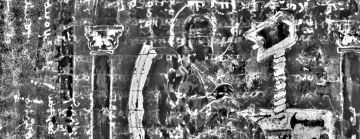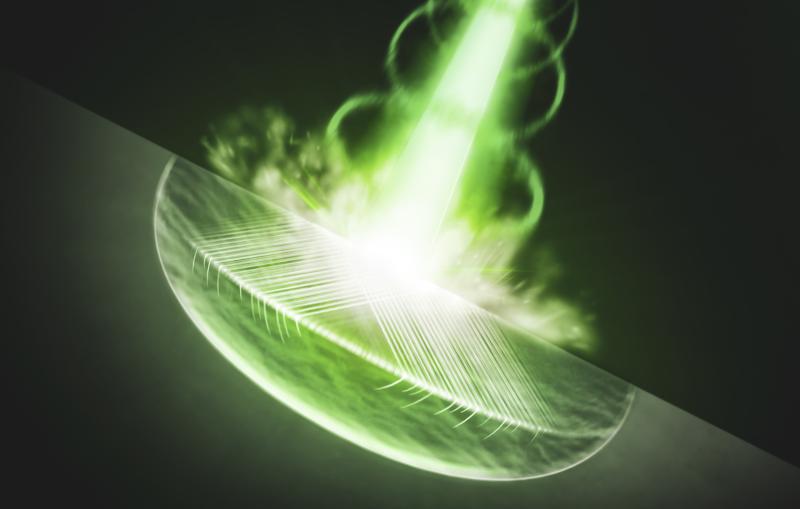Archimedes Manuscript Yields Secrets under X-ray Gaze
By Heather Rock Woods
For five days in May, the ancient collided with the ultra-modern at the Stanford Linear Accelerator Center (SLAC), bringing brilliant, long-hidden ideas to light with brilliant X-ray light. A synchrotron X-ray beam at the Department of Energy facility illuminated an obscured work—erased, written over and even painted over—of ancient mathematical genius Archimedes, born 287 B.C. in Sicily.
Archimedes' amazingly advanced ideas have been lost and found several times throughout the ages. Now scientists are employing modern technology—including X-ray fluorescence at SLAC's Stanford Synchrotron Radiation Laboratory (SSRL)—to completely read the Archimedes Palimpsest, the only source for at least two previously unknown treatises thought out by Archimedes in the third century B.C.
"Synchrotron light has revolutionized our view into the sub-microscopic world and has contributed to major innovations in fields including solid-state physics, materials science, environmental sciences, structural biology and chemistry," explained Keith Hodgson, director of SSRL. "Synchrotron light is created when electrons traveling the speed of light take a curved path around a storage ring—emitting electromagnetic light in X-ray through infrared wavelengths. The resulting light beam has characteristics that make it ideal for revealing the intricate architecture and utility of many kinds of matter—in this case, the previously hidden work of one of the founding fathers of all science."
Legend has it that Archimedes, upon displacing water in his tub and realizing he had found a way to measure volumes, leapt out of the bath and ran naked through the streets shouting 'Eureka!' (I have found it!). He also conceived a way to calculate pi, the mathematical equivalent of inventing the wheel. Archimedes did not just take steps toward calculus, as formerly believed; he actually created and used calculus methods, the basis for modern engineering and science. He is also credited with designing fearsome war weapons, such as claws that pulled attacking boats from the water.
The palimpsest is a 1,000-year-old parchment made of goatskin containing Archimedes' work as laboriously copied down by a 10th century scribe. Two centuries later, with parchment harder to come by, the ink was erased with a weak acid (like lemon juice) and scraped off with a pumice stone, and the parchment was written on again to make a prayer book.
One of the most intractable problems was seeing the original ink on four pages that had been painted over with Byzantine religious images, which turned out to be 20th century forgeries intended to increase the value of the prayer book.
An X-ray system recently showed it was possible to penetrate the paintings. At SSRL, the assembled team practically jumped with excitement as the original writing beneath one painting was unveiled on the computer screens. Archimedes' hidden text deals with floating bodies and the equilibrium of planes.
Three pages of the palimpsest recently traveled to Menlo Park because SSRL staff scientist Uwe Bergmann had his own Eureka moment in 2003. From a magazine article, he learned the inks used for both the Archimedes and religious texts contained iron pigment.
"I read that and I immediately thought we should be able to read the parchment with X-rays," Bergmann said. "That's what we do at SSRL—we measure iron in proteins—extremely small concentrations of iron."
The intense synchrotron X-ray beam induces X-ray fluorescence—X-ray light tuned to a specific energy causes the remaining traces of iron ink to fluoresce. A detector catches the fluorescence and renders the 2,000-year-old thoughts of the mathematical genius readable. Like an old dot-matrix printer, the detector builds an image dot by dot, mapping out each speck of iron-containing ink. Where the two texts overlap (they are written perpendicular to each other) the iron signal is stronger , which may allow researchers to separate the two texts.
"The Archimedes ink is only one to two microns thick—there's hardly anything there," said Abigail Quandt, head of book and paper conservation at the Walters Art Museum in Baltimore, which is leading a broad public and private effort involving experts from diverse fields to study and conserve the manuscript.
"This is for broad public interest, to reveal the mind of the greatest mathematician of antiquity," said Will Noel, curator of manuscripts and rare books at the Walters Art Museum. "There's nothing more important and more romantic in the history of ancient science and currently in the history of medieval manuscripts. We're discovering new readings of Archimedes."
Much of the manuscript has been read by visible or ultraviolet light during six years of painstaking analysis and restoration. For the rest, the main tools are X-ray fluorescence, optical character recognition (teaching a computer to recognize fragments of ancient Greek symbols) and multi-spectral imaging (using light of different wavelengths). Ametek-Edax of New Jersey makes an X-ray fluorescence system—which first revealed hints of text under the forged paintings—that could be installed at the museum to analyze pages that are too fragile to travel.
Another page studied at SSRL contains an introduction to the only copy of Archimedes' Method of Mechanical Theorems, where the genius showed how he arrived at his theorems. As ancient Greek cursive—mingled with the religious text—appeared on a screen, Stanford Classics and Philosophy Professor Reviel Netz began decoding the Archimedes text. He uses the four layers of text from the synchrotron images, which simultaneously register the scientific and religious texts from both sides of the parchment page, and multi-spectral images to build a picture of the 10th century pen strokes and rule out the curves and lines made two centuries later.
"I don't think X-rays will make invisible material simply visible," Netz said. "It will add a layer of information combined with others that will enable me to read the text."
An anonymous private collector who bought the palimpsest for $2 million at auction in 1998 has loaned the manuscript to the Walters Art Museum and is funding the studies. Researchers also come from RB Toth Associates, Rochester Institute of Technology, Johns Hopkins University, ConocoPhillips and Rutgers University.
The team plans to decipher the entire text, catalog and transcribe it digitally, and create an interactive DVD. They will then exhibit a few pages in 2008 before returning the irreplaceable parchment to its owner.
Contact
- Neil Calder, Stanford Linear Accelerator Center: 1 (650) 926-8707, neil.calder@slac.stanford.edu
Comment
- Uwe Bergmann, Stanford Synchrotron Radiation Laboratory, (650) 926-3048, bergmann@SLAC.Stanford.edu
Relevant Web URLs
About SLAC
SLAC National Accelerator Laboratory explores how the universe works at the biggest, smallest and fastest scales and invents powerful tools used by researchers around the globe. As world leaders in ultrafast science and bold explorers of the physics of the universe, we forge new ground in understanding our origins and building a healthier and more sustainable future. Our discovery and innovation help develop new materials and chemical processes and open unprecedented views of the cosmos and life’s most delicate machinery. Building on more than 60 years of visionary research, we help shape the future by advancing areas such as quantum technology, scientific computing and the development of next-generation accelerators.
SLAC is operated by Stanford University for the U.S. Department of Energy’s Office of Science. The Office of Science is the single largest supporter of basic research in the physical sciences in the United States and is working to address some of the most pressing challenges of our time.






